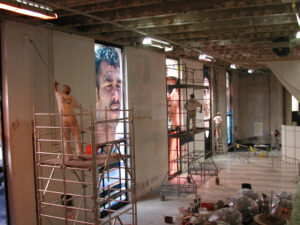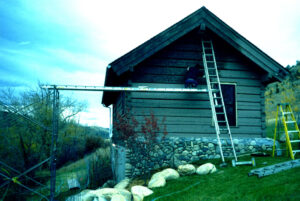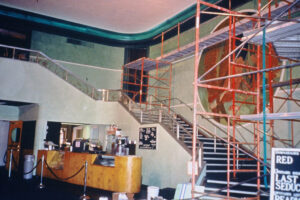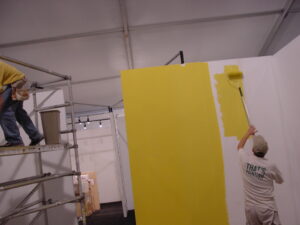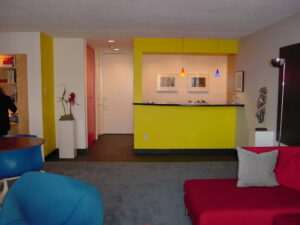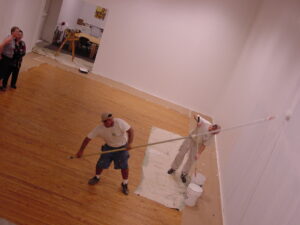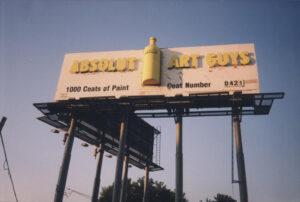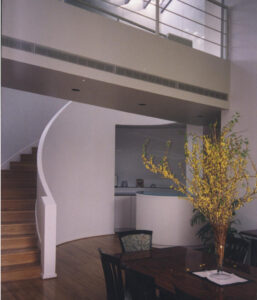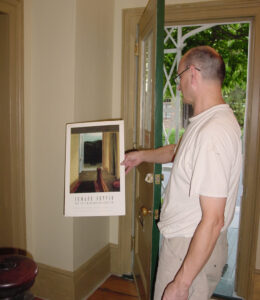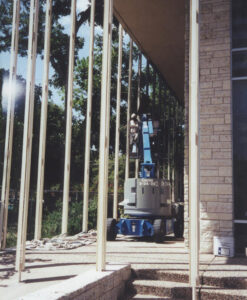“With less to look at, there’s more to think about.”
This is the motto I gave my company, That’s Painting Productions, some twenty years ago, when I started thinking about house-painting as an art form. Or rather when my work as a house painter became my activity as an artist. This development didn’t happen over night, and the following two interviews describe the process and explain the motivations behind this trajectory.
The first interview is a reprint of a discussion I had in 1993 with Michael Kosch, a composer and writer living in New York. I have known Michael since 1988, when I met him through a mutual friend, Allan Johnson. His sharp comments about contemporary visual art proved very helpful to me as I was trying to articulate the concepts involved in the shift from studio painting to house-painting. During my frequent visits to New York or his trip to Houston, we would discuss the various tendencies in contemporary art and their relevance to my work. His comments were always pointed and insightful, intrigued as he appeared to be by the direction my work was taking. As I was planning the first public manifestation of this ‘house-painting as art,’ in September 1993 –having been asked by The Art Guys to repaint their studio and present the painting in an exhibition– I thought that my conversations with Michael would be the perfect vehicle to carry to the viewer the ideas behind the work. I was very conscious that I was going to offer to the public coming to the opening an ‘empty’ gallery, with only a fresh coat of paint on the walls. And since I wanted the work to be taken seriously –not seen as a Dadaist gesture or a nihilist attitude, but as a questioning of painting and representation– I needed a way to communicate this new position in its full breadth. A video showing the paint application would have risked distracting from the painting itself –the video becoming the art work– and would have been too sententious and boring. A performance –doing the actual painting during the opening– wouldn’t have addressed the more subtle questions involved. The idea of an old-fashioned catalogue seemed the most appropriate device, and so I collected in a manila folder facsimiles of all the paperwork involved in the preparation and execution of the job: notes taken beforehand, estimate, receipts from the paint store, invoice, together with the transcription of the discussion I had had with Michael on August 3, 1993. For the exhibition opening on September 4, 1993, the catalogue was spread on a table for whoever wanted to read it. What is reprinted in the following pages is a transcription of our telephone conversation, and to this day I am surprised how well it covered most of the concepts involved. The conversation was very helpful to me, since it allowed me to articulate many aspects of the work that I had not had the chance to really assess, for instance, the fact that I was making art works rather than producing art objects. It also strengthened the conviction that, moving away from representation, I was now dealing head on with reality. It was instrumental in reinforcing my confidence about the direction the work had taken. And also, once these positions were spelled out on the page in black and white, I had no choice but to go with them!
Ever since, and especially within the last few years, I have wanted to do an updated version of this interview, as I felt the work had moved a considerable distance from the reflection on representation that was my main concern in the late ‘80s and early ‘90s, and into new territory involving far more than a purely pictorial investigation. When the prospect of publishing a book on That’s Painting materialized, I thought it would be the perfect opportunity to have another interview which would address the work now, fourteen years later, and assess the ground covered since 1993. Pascal Beausse’s questions, in an interview conducted via the Internet, allowed me to expand on the circumstance of an artist working within a business-like structure. This situation seemed like a given to me, and I almost took it for granted, since it is part of my daily routine. But the implications are vast, and I am grateful to Pascal for exploring this topic with me. The artist as service provider, working within a business structure, has become something of a new genre, particularly in France, where for the last four years, the Paris Biennale has been championing this type of work. The social consciousness I have gained from being the head of a small business is having a powerful impact on the way I see my work developing now. The responsibility involved in running a small company has become a major focus and is now as important as trying to address any formal or painterly questions.
It is interesting to put side by side these two interviews, fourteen years apart, as their juxtaposition brings into sharp focus the idea of house-painting as art and the way this concept has evolved, for me, over time. However, I feel that the work is still growing, and there are more questions to answer. It should be obvious that these two interviews, far from closing the subject and exhausting the problems raised by this type of work –house-painting as an art form– are but two sign posts along the way of an ongoing journey.
I would like to thank Béatrice Josse of FRAC Lorraine, Jody Blazec and Jack Massing of Houston Artists Fund, and Joel Savary, Cultural Attaché of the French Consulate in Houston, for their help with fund raising; Yvon Nouzille and Valérie Barot for their great talent in coordinating the project; Roger Willems of ROMA Publications for the excellent job designing the book; Michael Kosch whose insightful inquisitiveness helped me early on; Pascal Beausse for his sharp comments on the economic implications of being an artist running a business; André and Lise Didier for their generous hospitality; Kay Allen for her wonderful editing skills; and Nancy Ganucheau for being there all along.
Bernard Brunon, August 2007
Hear Bernard speak about his work here.
Visit Bernard’s site here.
